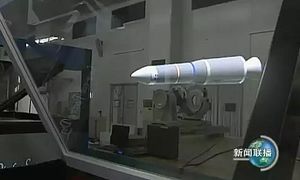The Chinese ballistic missile defense test that took place on February 5 involved a Dong Neng-3 (DN-3/KO09) hit-to-kill midcourse interceptor successfully striking a target DF-21 (CSS-5) medium-range ballistic missile, The Diplomat has learned from a U.S. government official with knowledge of China’s weapons programs.
The interceptor in the test was launched from the Korla Missile Test Complex, in China’s Xinjiang province. China has been conducting tests of the DN-3 interceptor since 2010. The system’s target capabilities are analogous to U.S. Standard Missile-3 midcourse interceptors, but it has yet to be successfully tested against an intermediate-range or intercontinental-range-class target. (The DN-3 is also thought to be physically much larger than the U.S. SM-3 series of missiles.)
The test was publicly reported by Chinese state media, though few details were provided. On February 5, PLA Daily reported that “China carried out a land-based mid-course missile interception test within its territory.”
The report added that the “test has achieved the desired objectives,” while noting that it was “defensive in nature” and “not targeted against any country.” The Chinese statement did not confirm that the test was intended to intercept a target missile.
This latest DN-3 interceptor test came shortly after India conducted the fifth known flight-test of its Agni-V missile, a near-intercontinental-range system, with a range within 5,000 to 8,000 kilometers, depending on its payload.
Exoatmospheric midcourse kinetic interceptors like China’s DN-3 target an incoming ballistic target after its active flight phase has concluded and the missile is outside the earth’s atmosphere, on its way toward descending at hypersonic speeds. This capability also makes the DN-3 a capable anti-satellite (ASAT) platform.
To successfully intercept targets in this phase, the interceptor must reach sufficient velocity and have sophisticated enough on-board sensors to successfully collide with the incoming target, using nothing but its kinetic energy to destroy the target.
China’s latest successful DN-3 test also comes just days after the U.S. Missile Defense Agency saw a second Standard Missile-3 Block IIA midcourse interceptor failure, compounding on a failure from 2017 that the Agency attributed to human error. (The test targeted a more challenging intermediate-range ballistic missile target than the MRBM-class DF-21 target the Chinese DN-3 intercepted.)
The DN-3 is thought to be China’s most capable midcourse hit-to-kill interceptor, but the country has other systems capable of exoatmospheric ballistic and anti-satellite interception, including the DN-2, the HQ-19, and the ASAT-oriented SC-19.
In 2017, the U.S. Department of Defense observed in its annual report on the Chinese military that the HQ-19 might “fill the midtier of China’s BMD network.”
“The HQ-19 is still undergoing PLAAF [People’s Liberation Army Air Force]-organized testing; as of May 2016, China was focused mainly on testing the HQ-19’s capability to intercept 3,000 km ranged ballistic missiles,” the report noted.
































